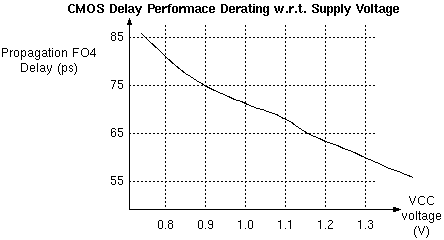HOME
UP
PREV
NEXT (Big/Little Proposition)
Save Power 4: Dynamic Voltage Scaling
CMOS delay is inversely proportional to supply voltage.
 |
Voltage to a region may be varied dynamically. A higher
supply voltage (at fixed f) uses more power (square law) but allows a higher f.
Operating region of the frequency/voltage curve is roughly linear.
But, logic with higher-speed capabilities is smaller which means it
(generally) consumes greater leakage current which is being wasted while we are halted.
Let's only raise VCC when we ramp up f.
|
Method:
- Adjust f for just-in-time completion (e.g. in time to decode the next frame of a real-time video),
- then adjust VCC so logic just works.
But Zeno applies still: always aim for
'a'
as high as possible and minimal halt cycles.
Overall: power will then have cubic dependence on f.
But this way we achieve peak performance under heavy loads and avoid cubic overhead when idle.
So a typical SoC uses not only many dynamic clock gated islands, but also some sub-continents with automatic
frequency and voltage variation.
Power isolation originally used on a longer and larger scale (complete continents) but now a lot of power islands
are being used.
It is possible to locally and quickly adjust supply voltage with a series transistor - but wasteful.
An off-chip power supply can be efficiently adjusted, but limited to only a few voltage islands and tens of milliseconds inertia.
For sub 45nm, voltage scaling may not be viable and static leakage may be very high: so clock within the frequency band that works and then power off until next deadline.
